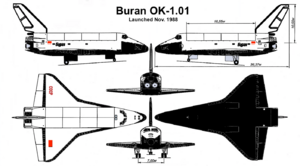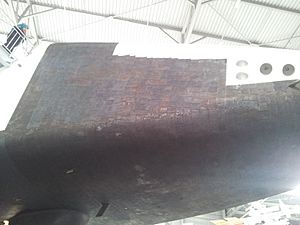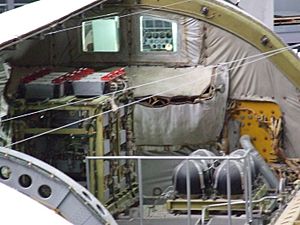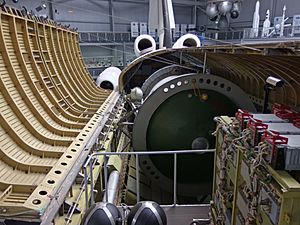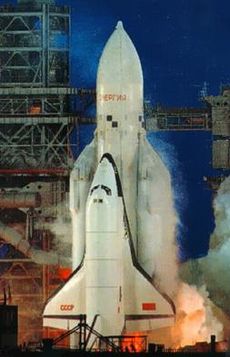Buran (spacecraft) facts for kids
Quick facts for kids 'Buran' |
|
|---|---|
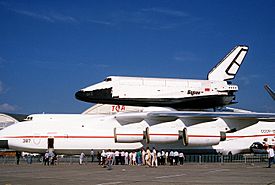
Buran on An-225 at the 1989 Paris Air Show
|
|
| OV designation | 1.01 |
| Country | Soviet Union |
| Named after | Russian for "Snowstorm" or "Blizzard" |
| Status | Destroyed 12 May 2002 |
| First flight | 15 November 1988 |
| No. of missions | 1 |
| Crew members | 0 |
| No. of orbits | 2 |
The Buran (which means "Snowstorm" or "Blizzard" in Russian) was the first spaceplane built as part of the Soviet/Russian Buran program. It was named after a strong Asian wind.
Buran completed one flight into space without a crew in 1988. Sadly, it was destroyed in 2002 when its storage hangar collapsed. The Buran space shuttles were launched using the powerful Energia rocket. This rocket was a super heavy-lift launch vehicle, meaning it could lift very heavy things into space.
The name "Buran" was used for both this specific space shuttle and the entire Soviet/Russian spaceplane project. All the spacecraft built for this project were called "Buran-class orbiters."
Contents
Building the Buran Space Shuttle
The construction of the Buran spacecraft began in 1980. By 1984, the first full-size orbiter was ready. More than 1,000 companies across the Soviet Union helped build and develop it. The Buran was designed to be launched by the Soviet Union's huge Energia rocket. The entire Buran program officially ended in 1993.
Here are some key dates in its construction:
- 1980: Building started.
- August 1983: The main body (fuselage) was delivered.
- December 1984: The orbiter arrived at the Baikonur launch site.
- April 1986: Final assembly began.
- 15 November 1987: Final assembly was finished.
- 15 November 1988: Buran made its first and only flight into orbit.
How the Buran Space Shuttle Worked
The Buran orbiter was built around its main body, called the airframe. This airframe held all the other parts together. The parts needed for flight made up about 20% of the orbiter's weight. The wings of Buran had special parts called elevators that could change position to help control the spacecraft.
Outside the Buran
Just like the US Space Shuttles, Buran was covered in many heat-shielding tiles. There were about 38,600 of these tiles! They were designed to protect the spacecraft from the extreme heat when it re-entered Earth's atmosphere. These tiles were very similar to those used on the US Space Shuttle.
The black coating on some of the tiles helped to get rid of heat. The tiles were glued to the orbiter, and small gaps were left between them. These gaps allowed the tiles to expand when they got hot without cracking. The gaps were filled with special materials to keep them sealed.
Buran and the US Space Shuttles faced similar temperatures. Buran had a slightly different way of arranging its heat tiles on the bottom. This design helped to reduce heat between the tiles and keep the air flowing smoothly over the spacecraft.
Inside the Crew Module
The crew module was a sealed, metal room where the astronauts would work and live. It had three levels:
- Flight Deck (Command Compartment - KO): This was the main workspace for the crew. It had seats for the commander, pilot, engineer, and mission specialist.
- Middeck (Habitation Compartment - BO): This area was for living and sleeping. It had lockers, a small kitchen, sleeping bags, and a toilet. Up to six crew members could sit here during launch and landing.
- Lower Deck (Aggregate Compartment - AO): This deck held important systems like life support, power, and temperature control.
The cockpit looked similar to the Space Shuttle's, with three computer screens.
Docking System
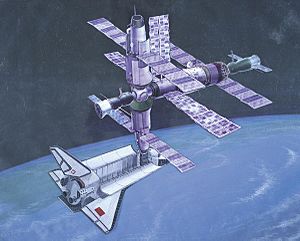
The docking module was placed at the front of the cargo bay. It was a round room with a tunnel leading to a special docking port. Unlike the US Space Shuttle, Buran's docking tunnel could extend. This helped create more space between Buran and the space station it was docking with. There was also a hatch for spacewalks from the orbiter.
Robotic Arm
Buran had a robotic arm called the Onboard Manipulator System. It was similar to the Space Shuttle's robotic arm. This arm could be controlled by a person or work automatically. It was used to help move things in the cargo bay. Depending on the mission, Buran could carry one or two of these robotic arms.
Laboratory Modules
To make Buran even more useful, special pressurized modules were designed. These were like small laboratories that could fit inside Burans cargo bay. They were used for experiments and carrying supplies. On Burans first flight, a unit called the Accessory Unit was installed. It held recording equipment and batteries to power the spacecraft.
Engines for Space Travel
Buran used a system called the Joint Propulsion System for moving around in orbit. These engines helped it change its path in space.
Automatic Landing System
One amazing feature of Buran was its automatic landing system. It could land the spacecraft completely by itself! It could guide Buran from 100 kilometers (about 62 miles) up in the air, controlling its flight as it slowed down from 28,000 kilometers per hour (about 17,400 mph) to a stop on the runway.
On its first flight, the automatic landing system did something unexpected. Because of strong, gusty winds, it made extra turns to lose speed and land safely. It was a very impressive feat of engineering!
Buran's Size and Power
The Buran orbiter itself weighed about 62 tons. It could carry a maximum of 30 tons of cargo. This meant its total weight at launch could be up to 92 tons.
Here are some of its main measurements:
- Length: About 36.37 meters (119 feet)
- Wingspan: About 23.92 meters (78 feet)
- Height on landing gear: About 16.35 meters (53 feet)
- Cargo bay length: About 18.55 meters (60 feet)
- Cargo bay diameter: About 4.65 meters (15 feet)
Unlike the US Space Shuttle, which used its own engines and solid boosters, the Soviet/Russian Energia rocket had powerful engines on its boosters and central core. These engines helped push Buran into space.
Buran's Flights
First and Only Orbital Flight
Buran's only flight into orbit happened on 15 November 1988. It launched at 3:00 AM UTC from the Baikonur Cosmodrome in Kazakhstan. Buran was lifted into space without a crew by the Energia rocket. Everything worked perfectly during the launch.
After reaching orbit and circling Earth twice, Buran's engines fired automatically to begin its journey back to Earth. It made an automated approach to the runway and touched down on its own at 6:24 AM UTC, just 206 minutes after launch. Even with strong crosswinds, Buran landed very close to its target. It was the first spaceplane ever to complete an uncrewed flight, including landing, in a fully automatic mode!
After the flight, engineers found that Buran had lost only eight of its 38,000 heat tiles. This was a very small number, showing how well it performed.
Planned Future Flights
In 1989, there were plans for Buran to have a second uncrewed flight by 1993. This flight was supposed to last 15 to 20 days. However, the dissolution of the Soviet Union (when the Soviet Union broke apart) led to a lack of money. The Buran program was never officially canceled, but funding stopped, and this second flight never happened.
Images for kids
See also
 In Spanish: Burán (transbordador) para niños
In Spanish: Burán (transbordador) para niños
- Buran programme
- List of Buran missions
- OK-GLI – Buran Analog BST-02 test vehicle
- Buran shuttle 1.02 "Ptichka"
- Buran shuttle 2.01
- Space Shuttle program – American spaceplane program


